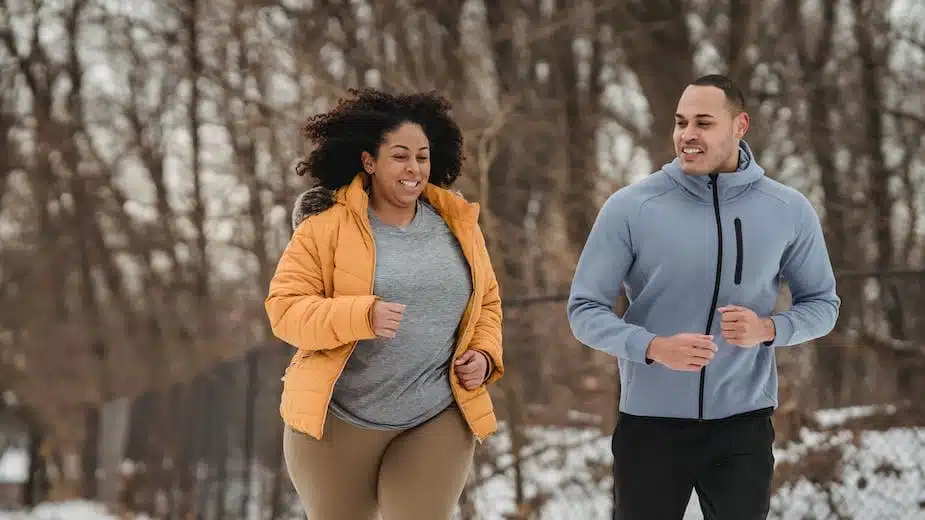The freezing air nips at your nose as soon as you step outside. Your breath fogs up your glasses and your joints creak in protest. The sidewalk glistens with icy patches just waiting to send you slipping.
Going for a run or bike ride in frigid winter weather might seem about as appealing as eating a pint of ice cream in one sitting – brain freeze! But with a few simple precautions, you can safely stay active even when there’s snow on the ground.
Whether you’re a hardcore winter athlete or just trying to keep up your new year’s resolution to exercise more, this complete guide to winter warm-up has the tips and tricks you need. We’ll cover how to adapt your training, what to wear, hydration and fueling considerations, and more so you can avoid injury and frostbite while getting the most out of your workouts.
Winter Warm-Up: Why It Matters
When temperatures drop, your cardiovascular system works harder to keep you warm. Blood vessels near the skin constrict to prevent heat loss, forcing your heart to pump faster to circulate blood to your extremities. The thickened blood and narrowed vessels put extra strain on your ticker.
At the same time, your joints and muscles literally freeze up. There’s less blood flow to feed oxygen and nutrients to working areas. Plus, tissues become less elastic in cold weather. Together, these winter side effects make strains and sprains more likely.
That’s why properly warming up before winter workouts is so important. Dynamic movements prep your tissues for exercise by increasing overall blood flow. Gradual activity slowly raises your core temp so you avoid going from zero to 60 too quickly.
Winter Warm-Up: Prep Your Body
Just like you wouldn’t drive your car without letting the engine warm up, don’t expect your body to perform without a little prep work.
Start by doing an easy 5-10 minute cardio activity like a brisk walk, light jog, or jumping jacks. This preliminary exercise elevates your heart rate and redirects blood flow from your core to your extremities.
Next, trade static stretching for dynamic movements that take joints through their full range of motion. Some ideas:
- High Knees: Run in place, pulling your knees up towards your chest. Hits quads, hip flexors, core.
- Butt Kicks: While jogging, kick your heels back towards your glutes. Targets hamstrings, quads, calves.
- Walking Lunges with a Twist: Lunge forward while rotating your upper body in the opposite direction. Full-body move!
- Arm Circles: Small controlled circles forward and back, increasing size. Loosens shoulders, upper back.
Customize your 5-10 minute winter warm-up based on your planned workout. Fiishing with sport-specific movements – a few paddle strokes for Nordic skiing, leg swings before a run, etc. – helps prepare the muscles you’ll use most.
Pro Tip: Still need help creating a winter warm-up routine? Ask your physical therapist for personalized suggestions.
Winter Warm-Up: Dress for Success
The right cold weather workout gear helps regulate body temperature so you stay comfortable and avoid dangerous drops in core temp. Follow the layering system, adding or shedding pieces as needed:
- Base layer – form-fitting to wick sweat from skin
- Insulation layer(s) – for warmth based on conditions
- Shell layer – water and wind-resistant
- Hand and foot protection – windproof, waterproof
- Head covering – traps heat, protects skin
Other winter gear must-haves:
- Thermal socks
- Winter sports bra
- Neck gaiter
- Reflective clothing
- Chemical hand/foot warmers
Don’t forget sun protection either! The winter sun reflects off snow and can still cause burns. Apply broad spectrum SPF 30+ sunscreen to all exposed skin. Shield eyes with UV-blocking sunglasses.
Stay Hydrated and Fueled
Dehydration danger is real even when temps are low. The dry winter air evaporates sweat quickly, making it harder to realize how much fluid you’re losing.
Aim to consume 5-10 ounces of water every 20-30 minutes during longer efforts. Electrolyte drinks help replace sodium lost in sweat. And contrary to popular belief, you can get dehydrated drinking hot beverages! Stick with good ol’ H2O whenever possible.
Easy-to-digest carbs and protein give working muscles the nutrients they need to perform in the cold. 30-60 grams of carbs per hour is a good benchmark. Real food options like dates, figs, nut butters on whole grain toast are excellent portable fuel sources. Just be sure to stash snacks inside your layers so they don’t freeze!
Nail the Cool Down
Just as critical as warming up, cooling down transitions your body from exercise back to rest. This helps flush waste products from tired muscles, prevents dizziness/fainting, and reduces next-day soreness.
After high-intensity training, walk or do an easy version of your sport for 5-10 minutes. Follow with ~10 minutes of static stretching while muscles are still warm. Foam rolling and light yoga also enhance flexibility gains.
Getting chilly? Continue cooling down inside with the same activities. Or hop in a warm (not hot!) shower. The heat dilates blood vessels, further removing lactate so you bounce back quicker.
Winter Warm-Up: 7 More Tips for Safe, Effective Cold-Weather Training
- Acclimate slowly. Gradually increase duration/intensity of workouts over 2+ weeks. This allows circulatory and metabolic changes to occur, reducing risk of frostbite and hypothermia.
- Stay visible. Wear bright and/or reflective clothing during dusk/dawn hours. LED lights add visibility for pre-sunrise/night efforts.
- Avoid cotton. The fabric soaks up sweat and loses any insulating value when wet. Opt for wool, silk, or synthetic moisture-wicking fabrics instead.
- Protect skin and extremities. Cover as much exposed skin as possible. Water-resistant gloves, socks, and shoes are essential for dry, warm hands and feet.
- Have an emergency plan. Carry a charged phone to call for help if needed. Know signs of hypothermia and frostbite. Train with a partner when possible.
- Choose safe surfaces. Clear snow/ice before exercising outside. Avoid hilly/isolated trails. Incline walking or snowshoeing slashes fall risk.
- Listen to your body. Skip outdoor workouts during extreme cold or wind chill advisories. Frostnip and superficial frostbite set in quicker below 0°F (-18°C).
Embrace Winter Workouts in Comfort
Old Man Winter loves sabotaging fitness goals with plummeting temperatures. But outsmart his sinister schemes using winter warm-up wise preparation outlined here.
Confront cold-induced joint/muscle stiffness by properly warming up/cooling down. Insulate yourself in technical, moisture-wicking layers. Fend off dehydration’s determinants and stretch to maintain flexibility despite the frost.
Take your winter warm-up seriously so discomfort, injuries and overexertion don’t hamper your plans. With some adjustments to gear, hydration, and training routine, you can embrace the season to reach your peak.
Now get out there, spike up your heart rate and play hard amidst winter’s wonderland. Don’t let Jack Frost freeze your fitness fun. The right winter warm-up is your ticket to safe, smile-inducing cold-weather activities all season long.



